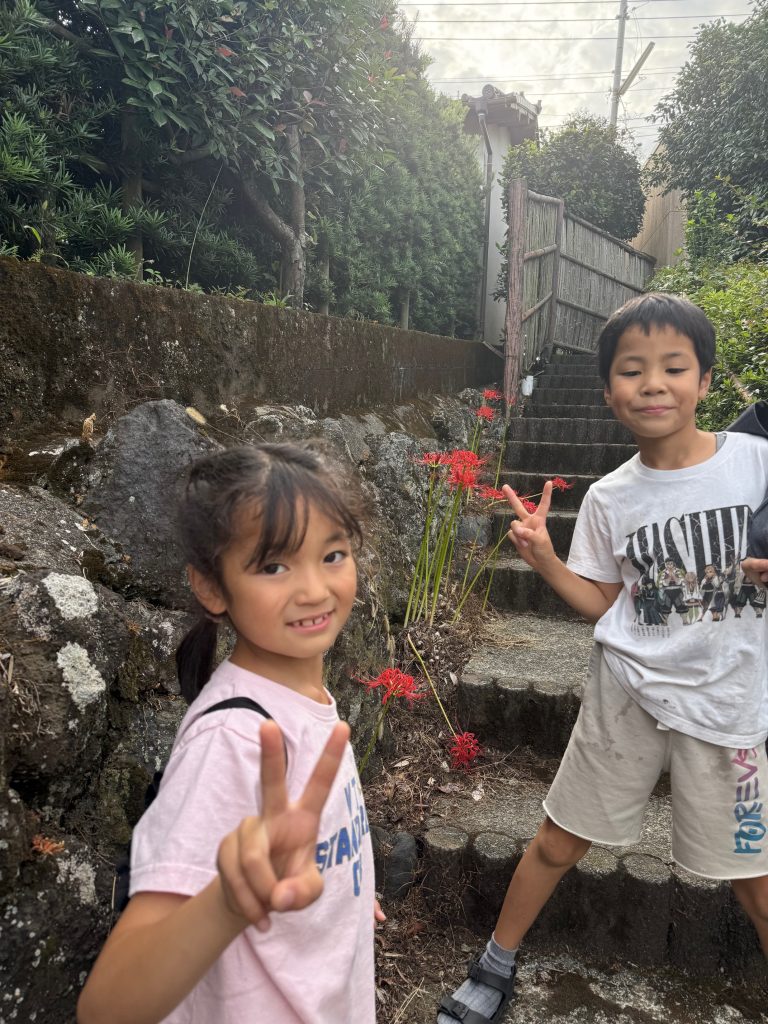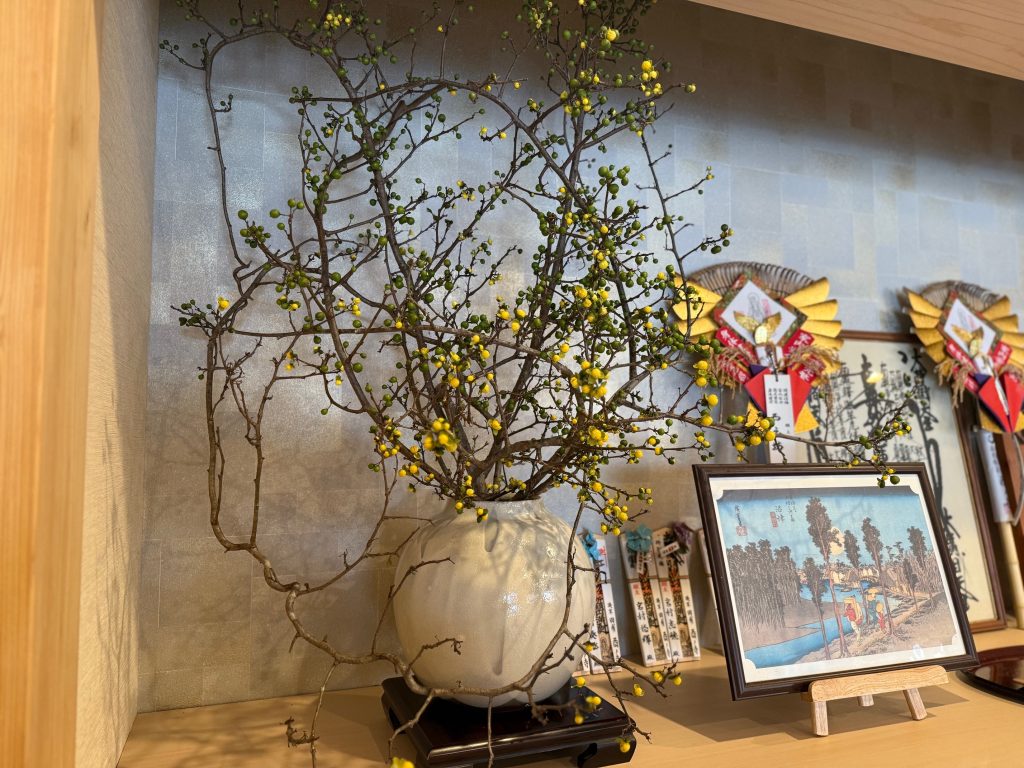第74回 ツルウメモドキを愛でる
There is an English translation at the bottom of this article. It’s a little bit long, however, please read it when you have time
お彼岸のお中日を迎えて
今日はお彼岸のお中日。
1ヶ月前、「熱中症になっては申し訳ない」と午前10時の法要を決め、
1週間前には「暑すぎるから、お塔婆はこちらで立てるようにしようか」と話し合いました。
ところが今朝の気温は、まさかの16℃。

そんな気候の揺らぎの中でも、彼岸花はきちんと咲いています。
その姿に、不思議さや感心、言葉にならない感情が湧いてきました。
彼岸とは「向こう岸」への修行
お彼岸とは、今私たちが生きる世界(此岸)から、向こうの岸(彼岸)へ近づこうとする修行の期間。
今は彼岸におられる方々も、昔からの習慣をご存知ですから、きっといつも以上に私たちを見守ってくださっていることでしょう。
では、どんな修行をすればよいのでしょうか。
まずは「南無妙法蓮華経」を唱えることが第一ですが、それ以外にも修行の方法は多岐にわたります。
今回はその中から、「布施」の実践に焦点を当ててみたいと思います。
六波羅蜜と「無財の七施」
仏教の修行法のひとつに「六波羅蜜」があります。
その第一項目「布施」は、財や心を他人に施すこと。
そして布施の中には、財がなくてもできる「無財の七施」があります。
六波羅蜜
├─① 布施(ふせ)… 財や心を他人に施すこと
│ └─ 無財の七施(むざいのしちせ)
│ ├─ 眼施(慈眼施)… 優しい眼差しで接する
│ ├─ 和顔施(和顔悦色施)… 穏やかな表情で人に接する
│ ├─ 愛語施(言辞施)… 思いやりある言葉を使う
│ ├─ 身施(捨身施)… 身をもって奉仕する
│ ├─ 心施(心慮施)… 他者の心に寄り添う
│ ├─ 壮座施(そうざせ)… 席や地位を譲る
│ └─ 房舎施(ぼうしゃせ)… 安らげる場を与える
├─② 持戒(じかい)… 心を戒め、迷惑をかけない
├─③ 忍辱(にんにく)… 不満を言わず、怒りを抑える
├─④ 精進(しょうじん)… 努力を惜しまず、全力で取り組む
├─⑤ 禅定(ぜんじょう)… 心を静かに保ち、反省を忘れない
└─⑥ 智慧(ちえ)… 真実を見抜く智慧と正しい判断力
今回はこの「無財の七施」の中から、「眼施」に注目してみましょう。
優しい眼差し──簡単そうにも思えますが、意外と難しい修行かもしれません。
人間の身体は基本的に脳の指令で動きます。
つまり、意識したように、考えたように動く。
他の布施と同じく、優しい気持ちで向き合わなければ、眼施は達成できないのです。
では、「優しい気持ち」とは何でしょうか。
いつもと違う接し方は、くすぐったく感じたり、気恥ずかしかったりするものです。
だからこそ、考え方に“流動性”と“優しさ”を持つことが大切なのではないでしょうか。
変化を愛でる
お彼岸を迎えるにあたり、玄関に『ツルウメモドキ』を飾っていただきました。
緑、黄色、オレンジへと変化していく色を楽しむのだそうです。

何かを感じ、対応し、変わっていく。
それを愛でる人がいる。
変わらないでいようとするのは、人間だけかもしれません。
それがもどかしさや不満、ストレスにつながる。
絶対に、少しずつ変わってしまうのに。
変化にあがらう努力も尊いことです。
でもそれと同じくらい、周囲の人々とともに、変化──もっと言えば、老いやうまくいかないこと──を楽しむ姿を、彼岸の方々に見せることもまた、修行になる・・・
そんな“プチ修行”としてのお彼岸の過ごし方、いかがでしょうか。
きっと、彼岸の方々も喜んでくださることでしょう。
さて、休みで騒がしい子どもたちを叱りに行ってきます。……おっと。
Admiring the Climbing Spider Lilies, Part 74
Celebrating the Middle Day of the Equinox
Today is the middle day of the Equinox.
A month ago, we decided to hold the memorial service at 10:00 AM, feeling it would be a shame if people suffered heatstroke.
A week ago, we discussed the possibility of erecting the gravestone here, as it was too hot.
However, this morning’s temperature was an astonishing 16°C.
Even in such fluctuating weather, the red spider lilies are blooming beautifully.
Their appearance filled me with a sense of wonder, admiration, and indescribable emotions.
Equinox: Training to the Other Shore
Equinox is a period of training to move from the world we live in now (this shore) to the other shore (the other shore).
Those who are currently in the other shore are familiar with these ancient customs, so I’m sure they are watching over us more than usual.
So, what kind of training should we do?
The first step is to chant “Namu Myoho Renge Kyo,” but there are many other ways to practice this.
Today, I would like to focus on the practice of “dana.”
The Six Paramitas and the “Seven Non-Material Givings”
One of the methods of Buddhist practice is the “Six Paramitas.”
The first of these, “dana,” involves giving one’s material and emotional resources to others.
And within the scope of giving are the “Seven Non-Material Givings,” which can be done even without material resources.
The Six Paramitas
├─① Dana (Giving): Giving one’s material and emotional support to others
│ └─ The Seven Non-Material Givings
│ ├─ Giving with Compassion (Giving with Compassion): Looking kindly at others
│ ├─ Giving with Kindness (Giving with Compassion): Treating others with a gentle expression
│ ├─ Giving with Kindness (Giving with Speech): Speaking with compassion
│ ├─ Giving with Self (Giving with Selflessness): Serving others with one’s own body
│ ├─ Giving with Heart (Giving with Consideration): Being considerate of others’ hearts
│ ├─ Giving with a Seat (Giving with a Seat): Giving up one’s seat or position
│ └─ Giving with a House (Giving with a House): Providing a place of comfort
├─② Keeping the Precepts (Maintaining the Precepts): Being mindful and not causing trouble
├─③ Patience… Not complaining and controlling your anger
├─④ Diligence… Working hard and giving your all
├─⑤ Meditation… Maintaining a calm mind and never forgetting to reflect
└─⑥ Wisdom… The wisdom to see the truth and sound judgment
Today, let’s focus on “giving with one’s eyes” from among the “Seven Non-Material Givings.”
A gentle gaze—while it may seem simple, it may actually be a surprisingly difficult practice.
The human body is fundamentally driven by commands from the brain.
In other words, it moves as we consciously and thoughtfully do.
Like other forms of giving, giving with one’s eyes cannot be achieved unless one approaches others with a gentle heart.
So what exactly is a “gentle heart”?
Interacting in a different way than usual can feel awkward or embarrassing.
That’s why it’s so important to maintain fluidity and kindness in your thinking.
Appreciating change
In preparation for the equinox, we had a Japanese quince displayed in our entranceway.
Apparently, people enjoy watching its colors change from green to yellow to orange.
We sense something, respond, and change.
Some people appreciate that.
Humans may be the only species that try to stay the same.
This leads to frustration, dissatisfaction, and stress.
Even though we will inevitably change, little by little.
The effort to adapt to change is also admirable.
But just as importantly, showing those around us how to enjoy change—and, more specifically, aging and things that don’t go well—is also a form of training…
Why not spend your equinox as a little training like this?
I’m sure the people of the equinox will be pleased.
Now, I’m off to scold the noisy kids for the holidays. …Oops.